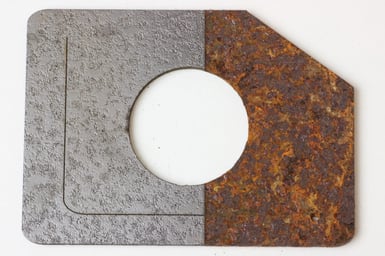While many of our customers are investing in laser systems as a solution to their engraving/marking needs, some are also embracing their capacity to efficiently and safely clean surfaces. Laser cleaning is the process by which contaminants, debris, or impurities (e.g. carbon, silicon, and rubber) are removed from the surface of a material by using laser irradiation. This is a low-cost and environmentally friendly laser application technique.
(Youtube: Needham Laser Technologies)
As you can see, laser cleaning is powerful, fast and effective. Here are some of the applications where surface modification using a fiber pulse laser is extremely useful:
Surface Cleaning

The most common industrial use of laser cleaning is rust removal from steel parts prior to painting or welding. Rust is commonly removed using abrasive tools or using strong cleaning solutions. Abrasive removal is a cumbersome process and is difficult on complex shapes. The corrosive solutions used also pose a safety risk to operators and to the environment when disposed of. Pulsed fiber laser systems, such as the N-Lase series, offer a cost effective, environmentally friendly method of rust removal and surface preparation.
Post weld/ thermal treatment cleaning

Welding and after heat treatments of metals can leave oxides and weld spatter on the surface of the metal which are not only an eyesore, but can cause corrosion, problems with subsequent manufacturing processes and reduce the adherence of paints and lacquers.
A high frequency pulsed fiber laser can be used to remove oxides and weld spatter from the surface, as shown here on this seam weld on titanium pipe, leaving a clean smooth surface.
Rubber mould and tool cleaning
Mould tools for rubber, injection moulding plastics and GRP require regular cleaning to prevent the part sticking in the mould and to ensure consistent part geometry.
This is sometimes done manually using scrapping tools on larger parts but must be done using chemical solvents on smaller and more complicated tools which have health and environmental concerns. Laser cleaning provides a rapid, cost effective technique to clean the mould without damaging the tools and without the use of any chemicals. The laser required for rubber mould tools is a cost-efficient lower power pulse fiber laser such as the N-Lase.
If you would like to learn more about how our N-Lase laser systems can provide an efficient and safe surface cleaning solution for you or your business please get in touch. Alternatively, if you would like to see the capability of our lasers first-hand, we provide demonstrations at our Shropshire HQ, virtually via Zoom or Microsoft Teams, or we can arrange to travel to your location. Book a demo now.




